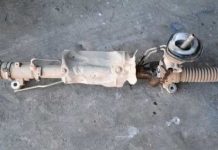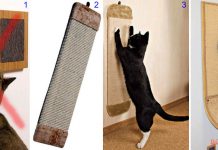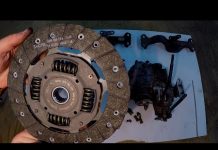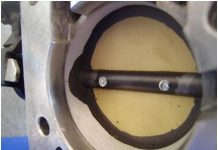Adjusting the front axle of the niva is one of the key operations that ensures comfortable and trouble-free travel on roads of any quality.
The need to adjust the elements of the front axle is assessed by the presence of noise and vibrations arising in various operating modes of the VAZ 21214. Thus, conditionally acoustic signs can be divided into two groups: • Registered constantly;
• Fixed when braking with internal combustion engine or acceleration.
By their nature, the sounds can resemble: • Howl (wear of the main pair); • Crunch, "trolleybus" hum (destruction or hauling of the liner bearings, loose nut of the drive shaft, axle shaft bearings, incorrect adjustment of the gears of the main gearbox); • Intermittent "scuffing" (differential bearing).
The complexity of diagnostics in this case lies in the abundance of extraneous noise emitted by other parts of the car.
To carry out adjustment work on the front axle, the manufacturer provides special pullers, mandrels and devices. However, due to their limited distribution and high cost, their presence is not necessary, although it is desirable to save time and accuracy of tuning. Since the main parts of the RPM correspond to similar elements of the REM, the correspondence of the technological clearances and the procedure for carrying out repair operations is traced.
The main stage is preceded by preparation, including: 1. Draining the oil from the RPM through the drain hole;
2. Disconnecting the propeller shaft with a key 13
3. Removing the right wheel drive.
4. Dismantling the lower ball joint on the left side.
5. Removal of suspension braces.
6. Removing the gearbox from the brackets on the right and left using the stop.
This is followed by disassembly of the gearbox, thorough cleaning of surfaces from dirt and grease, and troubleshooting of components.
To carry out the operation, the original device A.95690, mandrel A.70184 or an analogue made according to the drawing are used.
The seating plane of the crankcase is positioned so that it takes a horizontal position. Then an absolutely flat metal bar is installed on the bearing bed. The distance from the bar to the mandrel is measured by inserting the adjusting rings from the set in increments of 0.05 into the gap under the bar. The measured value (base of the crankcase) is consistent with the correction applied to the pinion. When reassembling the assembly, it is recommended that the standard spacer be discarded to prevent re-repair. Instead, a non-deformable steel sleeve with a length of 48 mm is suitable (with a margin, if necessary, shorten it).
During turning, the parts control the force when turning the gear (should be 157-196 N · cm), for bearings with mileage, a torque of 39.2–58.8 N · cm is valid. The use of a proprietary dynamometer 02.7812.9501 is optional.
Acceptable accuracy will be ensured by a household balance wheel. When working with it, wind one end of a 1 m long cord around the flange, and fasten the other to the balance. Lock the torque by pulling the device in a perpendicular direction. So, new bearings should provide 7-9 kg, and with mileage - 2-3 kg.
The process involves replacing the support washers with new ones - thicker than before. A choice of 7 standard sizes with a step of 0.05 mm in the range of 1.8-2.1 mm. Washers material - bronze or steel. In this case, the gears are installed tightly, but with the ability to turn manually.
In accordance with the instructions, the lateral clearance and bearing preload are adjusted using the A.95688 / R tool.
In its absence, a vernier caliper of a suitable size will perform the given role.
To ensure the required preload, the distance relative to the bearing caps is recorded at the beginning of the tightening and at the end of it. The required difference between the values is 0.2 mm.
The side clearance is adjusted by bringing the driven gear to the leading one until it disappears. Initially, one of the nuts is in a free position, the other (working) is tightened. After eliminating the gap, gradually tighten the baited nut until the jaws of the caliper move apart by 0.1 mm. The backlash adjustment stops when a slight knock of the teeth appears. Then both nuts are evenly tightened to a distance of 0.2 mm. The correctness of the work performed is evidenced by a uniform backlash at any position of the gears.
VIDEO
Rear axle bearings, side clearance and the position of the contact patch in the meshing of the main pair are adjusted at the factory, and, as a rule, they do not require adjustment during operation. Their adjustment is necessary only after the axle bulkhead and replacement of parts, as well as when the bearings are heavily worn. The lateral clearance in the engagement of the main gear, which has increased due to wear of the teeth, is not reduced by adjustment, since this leads to a disruption of the engagement and, as a result, to increased noise of the rear axle or to breakage of the teeth. Backlash in tapered bearings is eliminated without disturbing the mutual position of the driven and driving gears.
Adjusting the drive pinion bearing preload
The need for bearing adjustment can be determined by the presence of axial play in the pinion gear.The axial play is measured with a disconnected propeller shaft using an indicator with a graduation value of not more than 0.01 mm while moving the flange in the axial direction. In this case, the indicator leg should rest against the flange end parallel to the pinion gear axis.
Rice. 5.32. Rear axle with a banjo beam with a separate gearbox (middle part): 1 - nut; 2 - drive gear flange; 3 - cuff; 4, 6, 11 - bearings; 5 - ring; 7 - an adjusting ring; 8 - gear case; 9 - driving gear; 10 - differential; 12 - semiaxis; 13 - gasket; 14 - lock plate; 15 - crankcase; 16 - differential bearing nut; 17 - differential bearing cover; 18 - oil filler plug; 19 - driven gear; 20 - breather
The adjustment must be carried out as follows:
- unpin and unscrew the nut 1, remove the flange 2, the oil seal 3 and the inner ring of the bearing 4;
- replace the adjusting ring 5 with a new one, the thickness of which should be less than the one being replaced by the value of the axial play plus an additional 0.05 mm when the vehicle has traveled less than 1000 km or 0.01 mm when the vehicle has traveled more than 10,000 km;
- put in place the inner bearing ring, a new oil seal, flange and tighten the nut to a torque of 160-200 N · m (16-20 kgf · m), then check the ease of rotation of the drive gear. If more effort is required to rotate the drive gear than it was before the adjustment, then it is necessary to replace the adjusting ring by increasing its thickness by 0.01-0.02 mm.
After completing the adjustment of the bearing preload, tighten the nut to a torque of 160-200 N · m (16-20 kgf · m) until the slot in the nut coincides with the hole for the cotter pin. The nut must only be tightened to match the hole for the cotter pin with the slot of the nut, since otherwise, due to insufficient tightening, the inner ring of the outer bearing may turn, wear the adjusting ring and, as a result, increase the axial play of the bearings. When tightening the flange nut, it is necessary to turn the drive gear to correctly install the rollers in the bearings.
After adjustment, it is necessary to check the heating of the bearings after the vehicle has been moving at a speed of 60–70 km / h for 20–30 minutes. In this case, the heating of the crankcase neck should not exceed 95 ° C (water that gets on the neck should not boil). Reduce the preload if it gets too hot.
Adjust the preload when replacing the bearings of the drive gear and the main gear in the following order:
- it is necessary to adjust the position of the drive gear by selecting the adjusting ring 7 (see Fig. 5.32), ensuring the size (109.5 ± 0.02) mm - the distance between the common axis of the side gears and the end of the drive gear adjacent to the adjusting ring 7;
- by selecting the adjusting ring 5, adjust the bearing preload of the drive gear. With correct adjustment, the torque of resistance to rotation of the drive gear should be in the range of 150-200 N · m (15-10 kgf · cm) for new bearings or 70-100 N · m (7-10 kgf · cm) for operating bearings. If the moment of resistance to rotation of the bearings is within the normal range, the nut must be pinned, otherwise the adjustment must be repeated. In this case, if the torque of resistance to rotation is less than the required one, it is necessary to reduce the thickness of the adjusting ring, and if it is more, it is necessary to select a ring of greater thickness.
After adjusting the preload of the bearings, it is necessary to install the differential assembly into the axle and adjust the preload of the differential bearings and the lateral clearance in the meshing of the final drive gears.
Adjustment of differential bearing preload and lateral clearance in the meshing of gears and final drive
Adjustment without bearing replacement.
To adjust the bearings, you must:
- remove the axle shafts, the crankcase cover and the cover gasket (for one-piece rear axle);
- remove the axle shafts and remove the gearbox from the axle housing (for the rear axle with a banjo beam);
Rice. 5.33. Checking the axial clearance in the differential bearings (banjo axle)
Before removing, we clean the gearbox from dirt. We install the dismantled gearbox on the workbench.
Using a 10 spanner spanner, unscrew the eight nuts securing the front cover to the gearbox housing.
Using the "10" head, unscrew the bolt securing the locking plate of the left bearing cover of the differential box ...
... and remove the plate.
Using the "19" head, unscrew the four nuts securing the differential box bearing caps.
… Remove the cover of the left bearing of the differential box.
To remove the right bearing cover, screw the bolt into the hole for securing the lock plate ...
... and pulling on the bolt remove the cover.
We take out the adjusting nuts.
Remove the differential box assembly with the driven pinion of the final drive.
Removal of the driven gear and disassembly of the differential of the front axle reducer are similar to the corresponding work described in the section Disassembling the rear axle reducer.
Remove the oil deflector from the drive gear shank.
We take out the inner ring of the rear bearing of the pinion gear with a cage and rollers.
We take out the drive gear with an inner ring, a cage, a spacer sleeve and front bearing rollers.
Striking the punch with a hammer, knock out the outer ring of the front bearing ...
Likewise, dismantle the outer ring of the rear bearing.
... with the "10" head, unscrew the eight bolts of its fastening.
... and a gasket.
Checking the technical condition of parts, see the section Disassembling the rear axle gearbox. In addition, we check the condition of the bearings of the housings of the internal hinges of the drives. There should be no cracks or signs of wear on the seats of the gearbox housing. We replace the worn out and damaged parts with new ones.
Press the new outer rings of the pinion gear bearings with suitable pipe sections.
Assembly and adjustment of the front axle reducer are similar to the operations described in the section Disassembling the rear axle reducer.
Typically, the front axle gearbox needs to be removed if replaced or for repair. When disassembling, repairing and assembling the gearbox, it is assumed that special equipment is used and certain skills are required from the performer. If necessary, it is recommended to contact specialized workshops. If this is not possible, and the front axle gearbox must be removed, we provide a description of the work sequence.
Removing the front axle
Repair of the front axle gearbox - disassembly.
Install and secure the front axle at the repair stand.
Unscrew the plug and drain the oil from the crankcase.
Unscrew the nuts securing the bearing cover to the inner hinge housing and remove the hinge. When doing this, be careful not to damage the gasket.
Press the bearing off the inner hinge from the housing, first remove the circlip and spring washer. Remove the oil seal.
Remove the stamped cover and gasket from the axle housing.It is not recommended to remove the bottom cover.
Disassemble the front axle gearbox.
Installing the front gear.
The message in the conference "VAZ-classic" 02.11.06 (original), copied with the permission of the author.
By the way, the first sign of the axial play of the drive gear is the appearance of oil on the throat of the gearbox. When the vehicle is moving forward, the gear loads the rear bearing and relieves the front bearing, trying to “wriggle out” from the engagement. In this case, in addition to the axial play, a radial appears in the front bearing and the oil seal on the flange 1 no longer retains oil.
If you often have to drive the car in reverse, and even under load, uphill - the agony of the “sick” unit will not last long. The fact is that in the reverse mode, the drive gear, choosing the axial play, is screwed into the driven gear, as it were, shifting backward, which, with the tapered shape of the gear rims, causes a huge lateral force in the bearings. In especially advanced cases, the backlash progresses like an avalanche and the gear "goes" back so far that it mills a deep furrow on the surface of the differential box. Of course, the cemented layer on the working surfaces of the teeth will be worn out by that time, the tops of the teeth are rounded and the hum of the rear axle will turn into a growl with an eerie crunch ...
How can you determine the suitability of certain parts for reuse in a newly assembled gearbox? The main couple, perhaps, will still serve - the final verdict will make her a noise test. Do not be alarmed: instead of an expensive stand with an electric drive, you can use an ordinary knob with a 24 ”head from a large set of socket tools, and the measuring acoustic complex will replace your own ears. The assembled gearbox (without a spacer sleeve, oil seal, oil deflector, differential parts and stoppers, but with an adjusted gap in the engagement of the pair) is fixed in a vice, placing cardboard under the jaws so as not to jam the flange. Then quickly rotate the drive gear by the flange nut. If, instead of a soft rustle of bearings, a rumble resonating into the workbench cover is heard, even more so a pulsating one - we throw out the main pair without a shadow of a doubt - no adjustment "by the contact patch" will save it.
You can also reject the main pair visually, for example, if the tape of the top of the drive gear tooth is not uniform in width, as in the new one, but is narrowed in the middle part. The edges between the tops and working surfaces of the driven gear teeth must be sharp, like a turning tool. If you see the slightest nicks or roundings, throw away the steam without hesitation. And, of course, the main pair must be replaced if chipping of the cemented layer, waves, risks and other defects are visible on at least one of the teeth.
The differential box must be replaced if its journals are squashed and the new bearings are easy to put on by hand. It is unacceptable to grind the necks under the repair bushings - they are already thin. Whenever the gearbox is repaired, the bearings should be replaced with new ones, even if the old ones look quite functional. The saturation of oil with metal wear particles does not pass without leaving a trace for them, so the savings are more expensive here.
There is no need for expensive, heavy-duty jaw pullers to press out the bearing rings - they are superbly replaced by two hardened, thin-tongued mounting blades - much faster than fitting a fixture.In addition, when pressing the bearing rings into the crankcase or onto the gear with a puller, the following drawback appears: tightening its screw to failure, you will not feel the full fit of the ring around the entire circumference without a gap. It is possible that when the unit is in operation, it will settle down a little more, loosening the bearing preload. In my experience, it is safer to press in rings with a hammer using mild steel pipe pieces as mandrels. The first blows will be "sticky" - the ring moves along the neck or in the bore, and then the hand will feel the sharp return of the hammer - that means that everything is "gap - zero". A few more light, “stroking” strokes around the circumference and you can be sure - the ring is set all the way.
To match it with the new main pair, we subtract from it the amount of the correction applied with an electrographic pencil in the middle part of the drive gear. The marking, made in sloppy, sweeping handwriting, includes four digits of the main pair number (it is also stamped on the driven gear) and one or two correction digits with a "+" or "-" sign, denoting hundredths of a millimeter. For example, the base of the crankcase is 2.65 mm, and the correction is "-7". Subtract: 2.65 - (–0.07) = 2.65 + 0.07 = 2.72. This means that a ring 2.70 or 2.75 mm thick must be placed under the rear bearing of the drive gear. If you do not have this, you can grind a thicker one, for example, in a lathe or, at worst, rubbing it on a plane with sandpaper.
ATTENTION! In the picture, the length of the spacer sleeve is incorrect - it should be 48, not 44! (ALER: Corrected the number 4 to 8).
Having picked up the length of the sleeve, we disassemble the assembly again, rinse the parts and inspect them carefully. During the final assembly, be sure to install a new oil seal 2 (see Fig. Below) and, as a rule, oil slinger 3 is old, squeezed out unsuitable. There should be no groove on the flange 1 due to the work of the stuffing box. We degrease the thread of the gear with a solvent and lubricate it with reliable glue (epoxy, polyester, "Moment", etc.). We tighten the flange nut 27 (necessarily new - the one that was repeatedly tightened during adjustment is not suitable) we tighten "from the heart" - the thread withstands 30 kgf.m with a large margin. Now that all the parts on the pinion are pulled together by a force of 60 tons into a rigid, “monolithic” block, you can be sure that the bearing preload will be normal for many years.The glued nut will not turn away, loosen and loosen, as in the standard version, nothing can here anymore.
When assembling the unit, it is usually required to install new support washers 7 - thicker than the "native" ones. The half-axle gears must fit tightly into the differential, but turn by hand - this is what provides the Zhiguli bridges with silent and smooth, jerky-free operation (which has always caused the envy of Muscovites' owners). In total, there are seven standard sizes of support washers with a thickness of 1.8 to 2.1 mm (every 0.05 mm), and for any gearbox, both bronze ("classic") and steel ("Nivovskie") are equally suitable. If there are no washers of the required thickness, they are easy to make on a lathe - the part is primitive.
It is possible to adjust the side clearance in the main pair and the preload of the differential bearings without the monstrous device with two indicators (A.95688 / R) mentioned in the instructions. All this cumbersome equipment will completely replace a large caliper (see fig.). We measure the distance between the bearing caps before tightening the nuts and after. The difference should be 0.2 mm - this provides the required preload. To simultaneously adjust the lateral clearance in the gears, usually proceed as follows. By rotating one of the nuts 14 (the other is only baited), the driven gear is brought to the leading gear until the engagement gap is completely eliminated. Then the nut is screwed in until it stops and tightened by 1–2 teeth, while the vernier caliper shows an increase in the distance between the bearing caps by about 0.1 mm. Now we check the side clearance, and without any indicator. The required 0.08–0.13 mm is nothing more than the minimum perceptible play in engagement with the fingers, accompanied by a slight knock of the tooth against the tooth. It is enough to barely move the gears from the backlash-free position for it to appear. Additionally tightening both nuts 14, we achieve the divergence of the bearing caps to 0.2 mm while maintaining the required clearance in the main pair.
Before installing lock plates 16 and 17, slowly turn the driven gear three turns, probing for play in engagement on each tooth. If it is minimal and uniform for any position of the gears, consider that the gearbox is ideally adjusted. If in some sector of the teeth the gap disappears, causing the main pair to rotate tightly, the unit must be disassembled again. The runout of the differential box 12 can be easily eliminated in a lathe by milling the mating plane under the driven gear. Or you can just put in a new box. Individual "experts" sometimes allow the installation of a "curve" of the differential box, adjusting the side clearance in the tightest position.But since our today's conversation is devoted to the individual and high-quality assembly of the gearbox "for yourself", such recommendations are unacceptable here.
So, the "piece-made" gearbox is ready to serve you until the machine is decommissioned. But before putting it back in place, make sure that the rear axle beam is not bent. This often happens after driving with an overload, and the misalignment of the axle shafts quickly destroys their splined connection with the differential gears. To check it, it is not at all necessary to have a huge surface plate, flanges, prisms, etc., listed in the instructions. It is enough just to look through an empty beam - all four holes for the axle shafts (two in the flanges and two near the gearbox cavity) should be located strictly on the same line, and the slightest curvature is immediately noticeable to the eye. In this case, the beam will have to be replaced.
It is by this technique that I sort out the REMs.
Update as of 08/01/12, author of Scout-22.
I am attaching a couple of files so that you can bring the finished drawings to the turner.
Video (click to play).
The first picture is a preview, click to open the file in full size in a new window:









